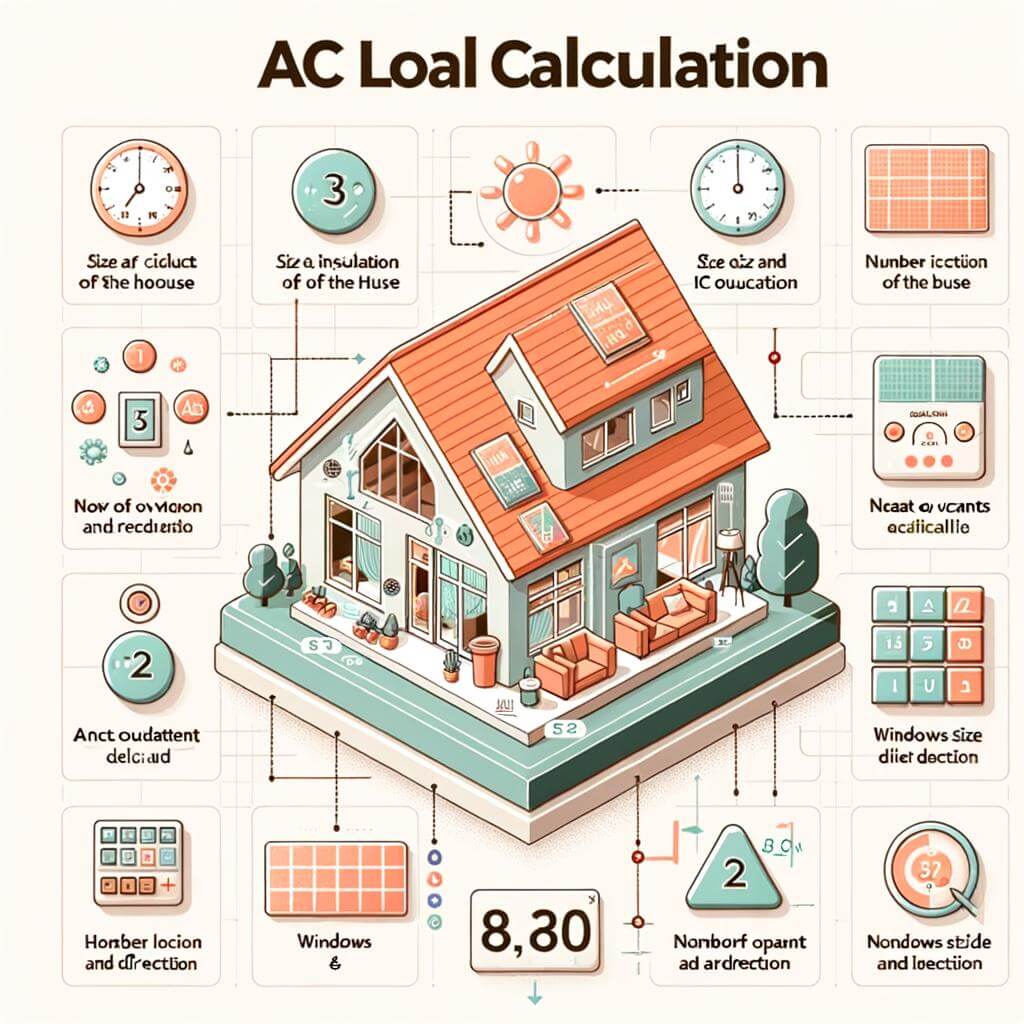Welcome to an insightful exploration of AC Load Calculations, their importance and application; a topic that plays a significant role within the fields of electrical engineering and HVAC design. In this enriching post, we will demystify complex concepts, helping you to understand the intrinsic value of accurate load calculations and how they can be applied optimally. With careful referencing to expert opinions and verifiable facts, this educational guide intends to enhance your knowledge and skills, irrespective of whether you are a novice learner or an experienced professional. You will find this content not only informative but also incredibly useful, and the best part is, we’ve made it easy to comprehend. So walk with us as we journey the path to better understanding AC Load Calculations.
Understanding the Basics of AC Load Calculations
Accurate AC load calculations are crucial to ensuring efficient energy use and preventing system overload. These calculations account for the amount of electricity required to operate air conditioning (AC) systems and play a decisive role in designing, sizing, and selecting suitable AC equipment. Whether you’re a homeowner trying to optimize your HVAC system or a professional engineer designing complex cooling systems, can be of immense help.
AC load calculations involve a number of variables to consider, including the size and insulation of the building, number of occupants, heat generated by appliances, and regional climate. Moreover, these calculations greatly underpin the comfort, energy efficiency, and operational cost of the AC system. Let’s break down these elements:
- Size and Insulation of the Building: The amount of space to be cooled and the building’s insulation level directly affect the cooling load. Larger buildings or poorly insulated ones will require more cooling capacity.
- Number of Occupants: More people means more heat generation, necessitating a higher cooling load.
- Heat Generated by Appliances: Electronic gadgets, appliances and lights emit heat, which increases the AC load.
- Regional Climate: Areas with warmer climates will need more cooling, resulting in a higher AC load.
Let’s dive into the impact of these factors in the table below:
| Factor | Impact on AC Load |
|---|---|
| Building Size and Insulation | Large, poorly insulated buildings increase AC load |
| Number of Occupants | More occupants lead to higher AC load |
| Heat from Appliances | Increased appliance use raises AC load |
| Regional Climate | Warmer climates result in higher AC load |
Your understanding of AC load calculations has a direct bearing on your ability to make informed decisions about AC equipment selection, energy usage optimization, and cost management. Remember, an accurately calculated AC load leads to an efficiently running system, ensuring comfort and longevity of your AC unit.

Significance of Accurate AC Load Calculations
The first thing to understand is that AC Load Calculation is a critical element when it comes to the design and efficiency of HVAC systems. By calculating the amount of heating and cooling, in BTUs, that a room requires, designers can accurately specify the correct size of equipment. Accuracy is of utmost importance. If the equipment is too large, you’ll have increased equipment costs and potential humidity problems. Conversely, if it’s too small, the unit will struggle to provide sufficient comfort levels and may overheat or freeze up causing equipment failure.
In practical application, these calculations take into account a variety of factors, including:
Size and layoutof the buildingOrientationrelative to the sunInsulationlevelsWindows(size, type, and number)Building materialsOccupancyHeat-producing appliancesand electronics
| Factor | Effect on AC Load Calculation |
|---|---|
| Size and Layout | Large or complex layouts may require more heating/cooling |
| Building Orientation | A building receiving direct sun requires more cooling |
| Insulation Levels | Poor insulation increases the heating/cooling needs |
| Windows | Large or numerous windows can increase heat gain |
| Building Materials | Some materials retain heat better than others |
| Occupancy | More people can lead to increased heat and humidity |
| Heat-producing Appliances | Electronics and appliances generate heat, increasing AC needs |
Taking these factors into account ensures that your HVAC system is not only efficient but also sufficiently powerful to keep the environment comfortable while minimizing energy consumption. Hence, accurate AC load calculations make not only economic sense but also contribute towards a sustainable environment.

Deciphering the Technical Aspects of AC Load Calculations
The technical aspects of AC load calculations encompass various elements that are essential for maintaining a controlled temperature in both residential and commercial areas. These calculations provide a clear understanding of the cooling and heating requirements of a building, based on its structural attributes. Therefore, understanding these technical aspects helps in selecting an appropriate size for the air conditioning system, ensuring energy efficiency and cost savings.
Some of the critical factors taken into consideration while performing AC load calculations are:
- Building Orientation: The direction the building faces impacts its exposure to sunlight, which influences the cooling requirements.
- Insulation: The more a building is insulated, the less cooling or heating it requires, reducing energy consumption.
- Size and Number of Windows: Large or numerous windows increase solar gain, thus increasing energy usage.
- Occupancy: A higher number of occupants adds to the heat load, increasing the cooling needs.
These factors are quantitively analyzed using the Manual J load calculation method, creating a model of the anticipated energy use of your air conditioning system.
| Aspect | Impact on AC Load |
|---|---|
| Building Orientation | Impacts Solar Exposure |
| Insulation | Reduces Energy Consumption |
| Window Attributes | Influences Solar Gain |
| Occupancy | Adds to Heat Load |
By utilizing a holistic approach towards AC load calculations, the architectural, environmental, and human factors contributing to your HVAC system’s effectiveness are taken into account. Understanding these intricacies can pave the way towards a more energy-efficient and cost-effective cooling and heating system, providing optimal comfort for the occupants.

Day-to-Day Applications of AC Load Calculations
When it comes to electrical systems, AC load calculations are vital for predicting electrical load demand in a residential or commercial setup. These calculations are everyday necessities in the fields of electrical engineering and appliance design. They serve as a solid basis for determining way ahead during system design and installation. Besides engineering, AC load calculations also find application in day-to-day areas.
An important application of AC load calculations is in the planning and installation of HVAC systems. Based on the anticipated load and level of energy consumption, HVAC professionals can estimate the appropriate type and size of unit required. Large commercial spaces, for instance, often require robust systems that can cater to high loads. On the other hand, small residential buildings typically require smaller systems.
- Understanding anticipated loads helps in adjusting power supply accordingly. Further it assists in avoiding the expensive issue of overloading.
- From the perspective of appliance manufacturing, AC load calculations also guide the design and development process. Here, they provide vital input regarding the functioning, size and capacity of appliances.
Furthermore, identifying power requirements are also essential during the integration of renewable energy systems. For those looking into solar power, calculating AC load gives them a better idea of how many solar panels they would need and where these panels could be installed efficiently.
| Application | Purpose |
|---|---|
| HVAC system planning | Estimate appropriate system size based on load and energy consumption |
| Appliance Manufacturing | Guide the design and development process |
| Integration of Renewable Energy systems | Identify power requirements for efficient installation |
AC load calculations also play a vital role in planning circuitry in residential and commercial builds. It can be used to determine the necessary size and capacity of electrical wires, outlets, and circuit breakers. This ensures that the installed electrical systems can safely and efficiently bear the desired electrical load.

Expert Tips for Efficient AC Load Calculations
When it comes to maintaining energy efficiency in our homes or workplaces, understanding AC load calculations is paramount. These calculations determine what capacity of air conditioning system you need for optimum cooling. An undersized or oversized AC system can lead to energy wastage, discomfort and unnecessary expense.
Here are some expert tips to ensure efficient AC load calculations:
- Consider the Area Size: Pay attention to the square footage of the area you want to cool. You’ll need around 20 BTU (British Thermal Units) per square foot for basic cooling needs.
- Factor in the Ceiling Height: Typically, the default height considered for load calculations is 8 feet. If your ceilings are higher, you’ll need to adjust the calculations accordingly.
- Insulation Matters: The quantity and quality of insulation in your walls, ceilings, and floors can greatly affect your AC load. Better insulation means less cooling needed.
- Sun Exposure: Rooms with more exposure to the sun will naturally be warmer and require more cooling.
- Account for Occupancy: The more people using a room, the more heat is generated. This should be considered in the load calculation.
Let’s illustrate these tips with a simple calculation. Consider a 300 sq.ft. room, with a ceiling height of 9ft, good insulation, moderate sun exposure, and typically occupied by 2 people:
| Parameter | Value |
|---|---|
| Area Size (sq.ft.) | 300 |
| Ceiling Height (ft.) | 9 |
| Insulation Level | Good |
| Sun Exposure | Moderate |
| Occupancy | 2 |
Using these values in the formulas commonly recommended by HVAC professionals, we can calculate the BTU requirements and get a sense of the AC capacity needed for this room.
Remember, efficient AC load calculations can assist in selecting the right AC unit, offer cost savings, ensure comfort, and conserve energy. By understanding and applying these concepts, you’re on your way to becoming an energy efficiency whiz!

Simplifying AC Load Calculation for Homeowners and Builders
When it comes to air conditioning (AC) systems in residential buildings, understanding AC Load Calculations is crucial to ensure a well-cooled environment. Builders and homeowners alike need this knowledge to make educated decisions on the appropriate size and power of an AC unit, ultimately enhancing comfort levels and energy efficiency.
Essentially, AC Load Calculation is a process of ascertaining the heating or cooling needs of any given space. It considers factors such as the building’s size, insulation quality, window area, and location among others. The resulting figure is measured in British Thermal Units (BTUs), representing the amount of heat that the AC system needs to add or remove to maintain a comfortable indoor climate. Let’s break this down:
- Size of the Building: A larger building will require more BTUs to cool or heat effectively.
- Insulation: The better the insulation, the fewer BTUs are necessary because the cooling or heating generated by the AC system is retained for longer.
- Window Area: As windows are typically the points with the least insulation, they affect the AC load calculations. The larger the window area, the higher the cooling or heating needs.
- Location: Geographic location plays a role too. A house in a hotter climate will obviously require more cooling power than one in a cooler area.
It’s crucial to understand that an undersized or oversized AC unit can result in reduced comfort, increased energy costs, and a reduced lifespan of the system. An undersized unit will continuously struggle to meet the cooling or heating demands, whereas an oversized one will cycle on and off too frequently, causing unnecessary wear and tear, and increasing your energy bill.
A professional load calculation can provide valuable insights, assisting in decision-making for AC unit selection and procurement. A proper assessment mitigates the risk of oversizing or undersizing your AC system — ultimately enhancing the comfort levels in your home and its overall energy efficiency.
Below we have a simple table outlining some general BTU requirements based on the size of your space:
| Area (sq. ft) | BTUs needed |
|---|---|
| 100-150 | 5000 |
| 150-250 | 6000 |
| 250-300 | 7000 |
| 300-350 | 8000 |
Of course, these are just rough estimates, and the specific characteristics of your home or building should be taken into account for an accurate AC Load Calculation.
In Conclusion
In the grand scheme of electrical design and applications, understanding AC load calculations stands as a significant and vital element. It’s crucial not only for engineers, technicians, or professionals working in this field but also for home, business owners, and anyone who deals in the purchase, installation, and maintenance of electronic equipment. Understanding the fundamentals ensures safety, longevity, and outstanding performances of your AC systems, which in effect, saves money and promotes sustainable living. Remember, knowledge is power when it comes to AC load calculations. Therefore, allocating time to learn these concepts deeply and applying them correctly is an investment made for a simpler, safer, and smarter future. You do not necessarily need to be a technical expert, a little bit of understanding goes a long way. This article only served as an introduction to the basics; there’s a vast landscape of knowledge to explore. We hope you found this article valuable in demystifying AC load calculations and their importance. Begin applying these concepts today, and you’ll definitely thank yourself later for the high-efficiency systems, reduced power issues, and cost savings. Keep on exploring, keep on learning, and don’t hesitate to consult with a professional when in doubt. The world of AC load calculations is wide and promising! Keep learning and keep growing!









